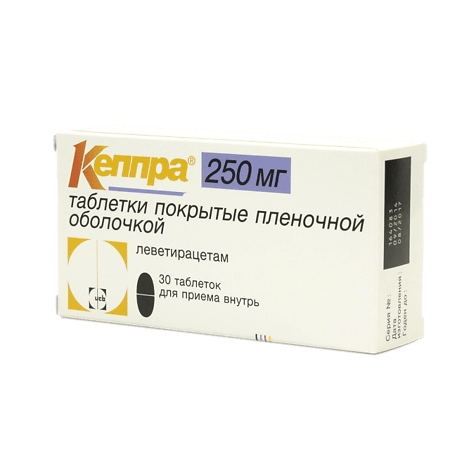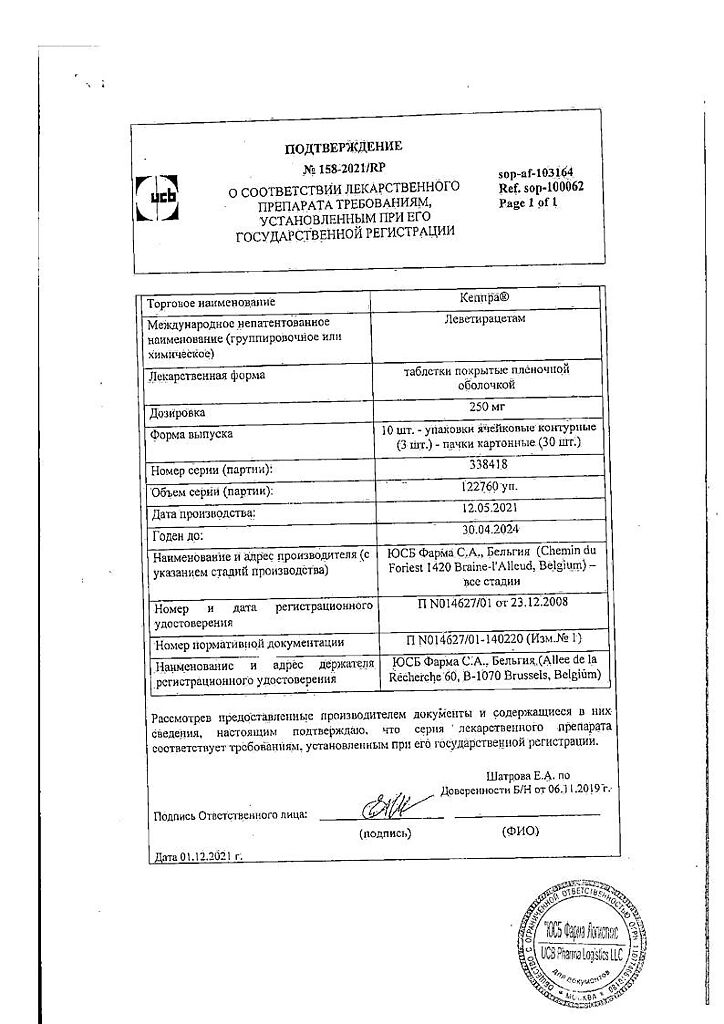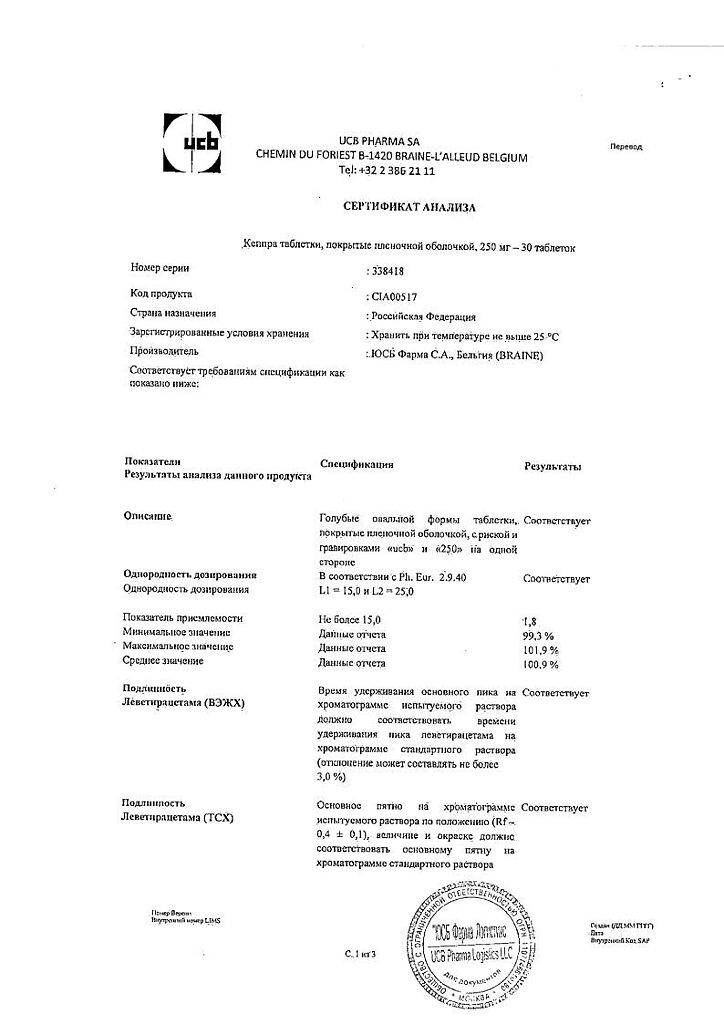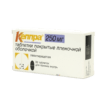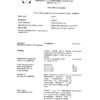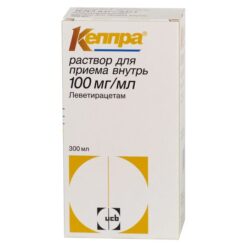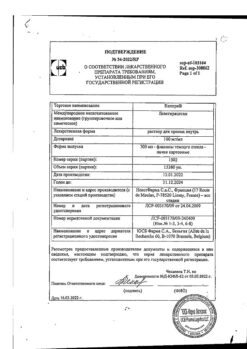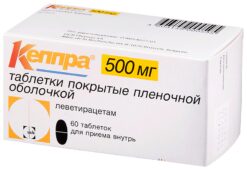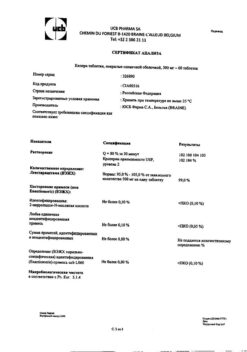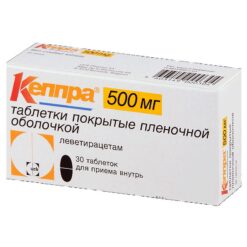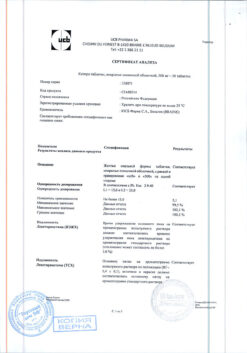No products in the cart.
Keppra, 250 mg 30 pcs.
€14.43 €12.50
Description
The antiepileptic drug, a pyrrolidone derivative (S-enantiomer of α-ethyl-2-oxo-1-pyrrolidine acetamide), differs from most known antiepileptic drugs by its chemical structure. The study of the mechanism of action of levetiracetam has not yet been completed, but it is clear that it differs from the mechanism of action of known antiepileptic drugs.
The results of an in vitro study showed that levetiracetam affects intraneuronal Ca2+ ion concentration by partially inhibiting Ca2+ current through N-type channels and reducing calcium release from intraneuronal depots. In addition, levetiracetam partially restores currents through GABA- and glycine-dependent channels reduced by zinc and β-carbolines.
One putative mechanism is based on proven binding to the glycoprotein of synaptic vesicles SV2A, found in the gray matter of the brain and spinal cord. It is assumed that this is how the anticonvulsant effect is realized, which is expressed in the counteraction of hypersynchronization of neuronal activity.
It does not alter normal neurotransmission, but suppresses epileptiform neuronal bursts induced by GABA-agonist bicuculline and excitation of glutamate receptors. The activity of the drug has been confirmed against both focal and generalized epileptic seizures (epileptiform manifestations/photoparoxysmal response).
Pharmacokinetics
Absorption
Levetiracetam is well absorbed from the GI tract after oral administration. Absorption is complete and linear, so plasma concentrations can be predicted based on the applicable dose of the drug in mg/kg body weight. The degree of absorption is independent of the dose and time of ingestion. Bioavailability is about 100%.
After 1 g dose of the drug, Cmax in plasma is reached after 1.3 h and is 31 mcg/ml, after repeated administration (2 times/day) – 43 mcg/ml.
Distribution
The equilibrium state is reached after 2 days with twice-daily administration of the drug. Binding to plasma proteins of levetiracetam and its main metabolite is less than 10%. Vd levetiracetam is about 0.5-0.7 l/kg.
Metabolism
The formation of the primary pharmacologically inactive metabolite (ucb L057) occurs without involvement of cytochrome P450 isoenzymes in the liver. Levetiracetam does not affect the enzymatic activity of hepatocytes.
In adults T1/2 from plasma is 7±1 h and does not vary with dose, route of administration or repeated administration. Mean clearance is 0.96 ml/min/kg. 95% of the dose is excreted by the kidneys. Renal clearance of levetiracetam and its inactive metabolite is 0.6 ml/min/kg and 4.2 ml/min/kg, respectively.
Pharmacokinetics in special clinical cases
In elderly patients, T1/2 increases by 40% and is 10-11 h due to decreased renal function in this population.
In patients with impaired renal function, the clearance of levetiracetam and its primary metabolite correlates with creatinine clearance. Therefore, in patients with renal impairment, it is recommended that the dose be adjusted according to the CKR. In terminal renal failure in adult patients, the T1/2 is 25 h between dialysis sessions and 3.1 h during dialysis. Up to 51% of levetiracetam is removed during a 4-hour dialysis session.
In a 4-hour dialysis session, 51% of levetiracetam is removed from the body.
In patients with mild to moderate hepatic impairment there is no significant change in the clearance of levetiracetam. In severe hepatic impairment with concomitant renal failure, the clearance of levetiracetam is reduced by more than 50%.
The pharmacokinetics of levetiracetam in children is linear in the dose range of 20 to 60 mg/kg/day. Cmax is reached after 0.5-1 h. T1/2 in children after a single oral dose of 20 mg/kg body weight is 5-6 h. Total clearance of levetiracetam in children is about 40% higher than in adults and is in direct relation to body weight.
Indications
Indications
As monotherapy (first choice drug) in the treatment of:
As part of complex therapy in the treatment of:
Active ingredient
Active ingredient
Composition
Composition
Associates:
croscarmellose sodium,
MacroGol 6000,
Silicon dioxide,
Magnesium stearate.
Composition of the film coating:
Opadray 85F20694 (indigo carmine dye (E132), macrogol 3350, polyvinyl alcohol partially hydrolyzed, talc, titanium dioxide (E171)).
How to take, the dosage
How to take, the dosage
The daily dose is divided into two equal doses.
Monotherapy
Adults and adolescents over 16 years of age are given the drug in the form of tablets or oral solution in an initial dose of 500 mg divided into 2 doses (250 mg 2 times daily). After 2 weeks, the dose may be increased to the initial therapeutic dose of 1 g (500 mg twice daily). Maximum daily dose is 3 g (1.5 g 2 times per day).
In combination therapy
In children from 1 month to 6 months of age the drug is indicated in the form of oral solution. The initial therapeutic dose is 7 mg/kg 2 times/day. Depending on clinical efficacy and tolerability, the dose may be increased to 21 mg/kg 2 times/day. Dose changes should not exceed plus or minus 7 mg/kg 2 times/day every 2 weeks. The minimum effective dose should be administered.
The dosing recommendations for Keppra® in the form of an oral solution for children under 6 months of age are shown in the table below.
In children aged 6 months to 23 months, children aged 2 years to 11 years, and adolescents aged 12 years to 17 years with a body weight less than 50 kg, treatment should be started with a dose of 10 mg/kg body weight divided into 2 doses (10 mg/kg body weight 2 times/day). Depending on clinical response and tolerability of the drug, the daily dose may be increased to 30 mg/kg 2 times/day. The dose may be changed by 10 mg/kg of body weight every 2 weeks. The minimum effective dose should be used.
The dose for children with a body weight of 50 kg or more is the same as for adults.
The recommended doses for children 6 months and older are listed in the table.
In children over 4 years of age, treatment should be started with a daily dose of 20 mg/kg body weight divided into 2 doses (10 mg/kg body weight 2 times/day). The dose may be changed by 20 mg/kg of body weight every 2 weeks until the recommended daily dose of 60 mg/kg of body weight (30 mg/kg of body weight 2 times/day) is reached. In case of intolerance to the recommended daily dose, it may be reduced. The minimum effective dose should be used.
The drug should be given in the most appropriate dosage form and dose depending on the patient’s body weight and the required therapeutic dose.
In children with body weight ⤠20 kg it is recommended to start treatment with the drug in the form of oral solution.
In children with a body weight of > 50 kg the dosing is carried out according to the scheme given for adults.
Adults and adolescents over 16 years of age with body weight over 50 kg should start treatment with daily dose of 1 g divided into 2 doses (500 mg 2 times per day). Depending on clinical reaction and tolerability of the drug, the daily dose may be increased to a maximum of 3 g (1.5 g 2 times/day). The dose can be changed to 500 mg 2 times per day every 2 to 4 weeks.
Because levetiracetam is excreted by the kidneys in elderly patients and patients with renal impairment, the dose should be adjusted according to the CK levels.
The CK can be calculated based on serum creatinine concentration using the following formula.
For men:
CK (ml/min)= [140-age (years)] Ã body weight (kg)/72 Ã serum creatinine (mg/dL)
For women: value obtained x 0.85
* – On the first day of treatment with Keppra®, a saturation dose of 750 mg is recommended.
** – After dialysis, an additional dose of 250-500 mg is recommended.
In children with renal impairment, the dose of levetiracetam should be adjusted according to the degree of renal impairment, using the recommendations given for adults.
Patients with mild to moderate hepatic impairment do not require dosing adjustments. In patients with decompensated liver function impairment and renal failure, the CK value may not reflect the true degree of renal function impairment; therefore, for CK
Principles of Administration
The tablets should be taken orally with plenty of fluid, regardless of meals.
Dosing of the solution is done with the help of a syringe with a nominal capacity of 10 ml (corresponding to 1 g of levetiracetam) and with the divisional value of 25 mg (corresponding to 0.25 ml), which is included in the preparation’s package. The measured dose of the drug is diluted in a glass of water (200 ml).
To dispense the solution using the syringe measure, open the bottle by pressing down on the cap and turning it counterclockwise. Insert the syringe adapter into the neck of the bottle, then take the syringe and place it in the adapter. Turn the bottle upside down. Fill the syringe with a small amount of solution by pulling the piston down, then push the piston upward to remove air bubbles. Pulling the plunger, fill the syringe with solution to the divisions corresponding to the number of ml of solution prescribed by the doctor. Take the syringe out of the adapter. Put the contents of the syringe into the beaker of water by pushing the piston all the way down. The entire contents of the cup should be drunk. Then rinse the syringe with water and close the bottle with the plastic cap.
Interaction
Interaction
Levetiracetam does not interact with anticonvulsants (phenytoin, carbamazepine, valproic acid, phenobarbital, lamotrigine, gabapentin and primidone).
Levetiracetam in a daily dose of 1 g does not change the pharmacokinetics of oral contraceptives (ethinylestradiol and levonorgestrel).
Levetiracetam in a daily dose of 2 g does not change the pharmacokinetics of warfarin and digoxin.
Digoxin, oral contraceptives and warfarin do not affect the pharmacokinetics of levetiracetam.
When co-administered with topiramate, there is a higher likelihood of developing anorexia.
The completeness of absorption of levetiracetam is not affected by food, but the rate of absorption is slightly reduced.
There are no data on the interaction of levetiracetam with alcohol.
Special Instructions
Special Instructions
If discontinuation of the drug is required, it is recommended that it be done gradually, reducing the single dose by 500 mg every 2-4 weeks. In children, dose reduction should not exceed 10 mg/kg of body weight 2 times/day every 2 weeks.
The concomitant antiepileptic drugs (while patients are being switched to levetiracetam) should be withdrawn gradually.
Patients with renal disease and decompensated liver disease are advised to have renal function tests before starting treatment. Dose adjustment may be required if renal function is impaired.
In view of the reported cases of suicide, suicidal ideation, and suicide attempts during treatment with levetiracetam, patients should be warned to immediately report any symptoms of depression or suicidal ideation to the treating physician.
The oral solution contains maltitol, so patients with impaired fructose tolerance should not take Quepra® in the appropriate dosage form.
Pediatric use
The available data on the use of the drug in children do not indicate any negative effect on development and puberty. However, long-term effects of treatment on children’s learning ability, intellectual development, growth, endocrine gland function, sexual development and fertility remain unknown.
The effect of Keppra® on driving and operating ability has not been specifically studied. Nevertheless, due to different individual CNS sensitivity to the drug during the treatment period it is necessary to refrain from driving vehicles and engaging in potentially dangerous activities requiring increased concentration and quick psychomotor reactions.
Contraindications
Contraindications
Patients of advanced age (>65 years), decompensated liver disease, renal failure should use the drug with caution.
Perhaps with caution in elderly patients (>65 years).
Side effects
Side effects
Possible side effects are listed below by body system and frequency of occurrence: very common (>1/10), common (>1/100,
CNS side effects: very common – somnolence, asthenic syndrome; common – amnesia, ataxia, seizures, dizziness, headache, hyperkinesia, tremor, impaired balance, decreased concentration, impaired memory, agitation, depression, emotional lability, mood swings, hostility/aggressiveness, insomnia, nervousness, irritability, personality disorders, thought disorders; occasional paresthesias, behavioral disorders, anxiety, restlessness, confusion, hallucinations, irritability, psychotic disorders, suicide, suicide attempts and suicidal ideation.
Visual organs: often – diplopia, accommodation disorder.
Respiratory system disorders: often – increased coughing.
Gastrointestinal system: often – abdominal pain, diarrhea, dyspepsia, nausea, vomiting, anorexia, weight gain; in some cases – pancreatitis, liver failure, hepatitis, changes in liver function tests, weight loss.
Dermatological reactions: frequently – skin rash, eczema, itching; in single cases – alopecia (in some cases hair regrowth was observed after discontinuation of the drug), Stevens-Johnson syndrome, erythema multiforme, toxic epidermal necrolysis.
Hematopoietic system: in single cases – leukopenia, neutropenia, pancytopenia (in some cases with suppression of bone marrow function), thrombocytopenia.
Others: in some cases – infections, nasopharyngitis, myalgia.
Overdose
Overdose
Symptoms: drowsiness, anxiety, aggressiveness, depression of consciousness, respiratory depression, coma.
Treatment: in the acute period – induced vomiting and gastric lavage followed by administration of activated charcoal. There is no specific antidote for levetiracetam. If necessary, symptomatic treatment under hospital conditions using hemodialysis (dialysis efficiency for levetiracetam is 60%, for its primary metabolite – 74%).
Pregnancy use
Pregnancy use
Adequate and rigorously controlled clinical studies on the safety of levetiracetam in pregnant women have not been conducted. Animal studies have revealed reproductive toxicity. Therefore, the drug should not be administered during pregnancy unless absolutely necessary.
Physiological changes in the female body during pregnancy may affect plasma concentrations of levetiracetam, as well as other antiepileptic drugs. During pregnancy, a decrease in plasma concentrations of levetiracetam has been observed. This decrease is more pronounced in the first trimester (up to 60% of the baseline concentration in the period preceding pregnancy). Treatment with levetiracetam in pregnant women should be performed under special supervision. Interruptions in antiepileptic therapy may worsen the course of the disease, which may be harmful to the health of both mother and fetus.
Levetiracetam is excreted with breast milk, so breastfeeding while taking the drug is not recommended if it is necessary during lactation. However, if treatment with levetiracetam is necessary during lactation, the balance of risk to the baby versus benefit to the mother should be carefully weighed against the importance of lactation.
Pediatric use
Contraindications: Children under 4 years of age (for tablets) (safety and effectiveness of the drug have not been established); children under 1 month of age (for solution) (safety and effectiveness of the drug have not been established);
Similarities
Similarities
Additional information
| Shelf life | 3 years in its original packaging |
|---|---|
| Conditions of storage | In a dry place, at a temperature not exceeding 25 °C |
| Manufacturer | UCB Farma, Belgium |
| Medication form | pills |
| Brand | UCB Farma |
Other forms…
Related products
Buy Keppra, 250 mg 30 pcs. with delivery to USA, UK, Europe and over 120 other countries.

